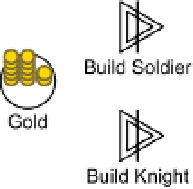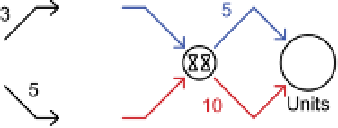Game Development Reference
In-Depth Information
the resource to that color. For example,
Figure 6.13
uses this construction to ran-
domly produce red and blue resources with an average proportion of 7/2.
FIGURe 6.13
Producing resources
with random colors
Delays and queues can use color coding. By giving them outputs with different col-
ors, they will delay resources of the corresponding color by a number of time steps
indicated by that output. For example,
Figure 6.14
represents the mechanics of a
game where players can build knights and soldiers. Knights are represented as red
resources, and soldiers are represented as blue resources. Knights cost more gold and
take more time to build.
FIGURe 6.14
Using color coding to
build different units
with one building
queue
The structure of a game's internal economy plays an important role in a game's
dynamic behavior and gameplay. In this structure, feedback loops play a special
role. A classic example of feedback in games can be found in
Monopoly
where the
money spent to buy property is returned with a profit because more property will
generate more income. This feedback loop can be easily read from the Machinations
diagram of
Monopoly
(
Figure 6.15
): It is formed by the closed circuit of resource and
state connections between the Money and Property pools.
FIGURe 6.15
Monopoly


























